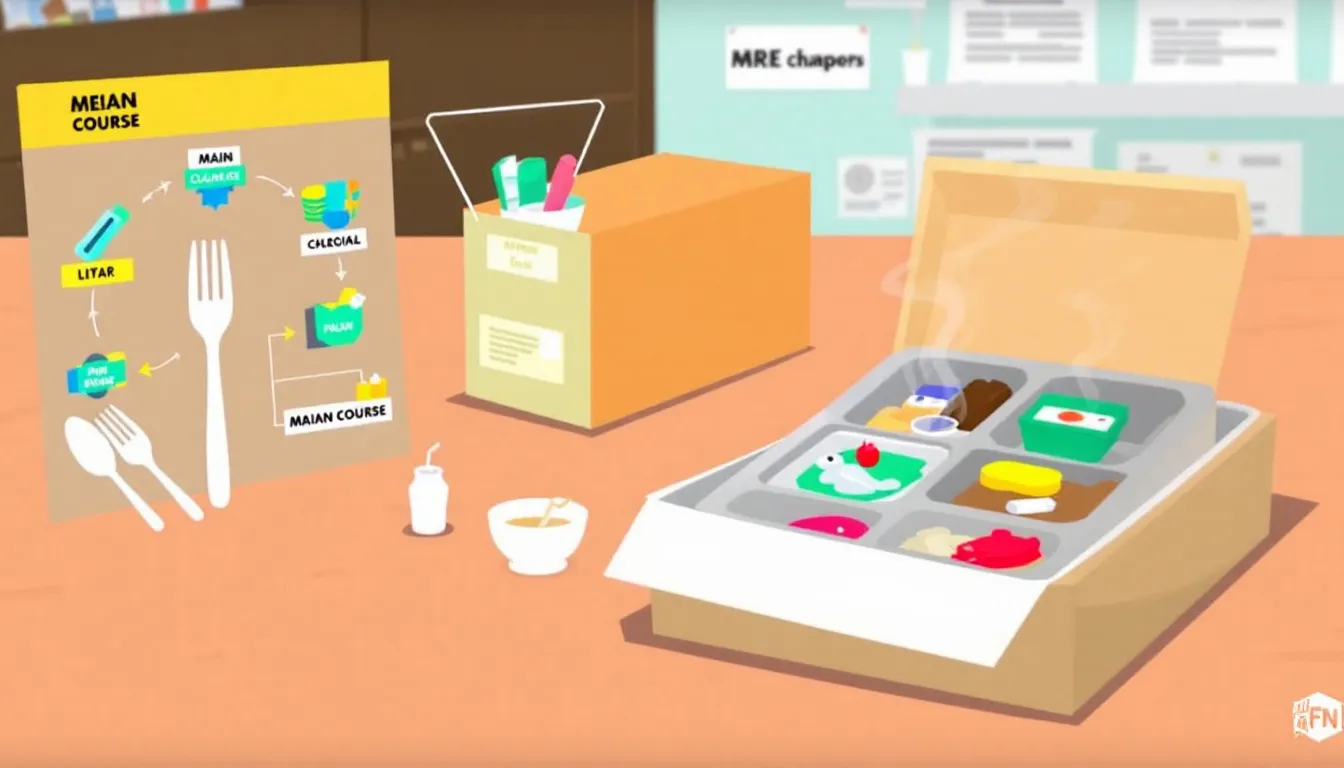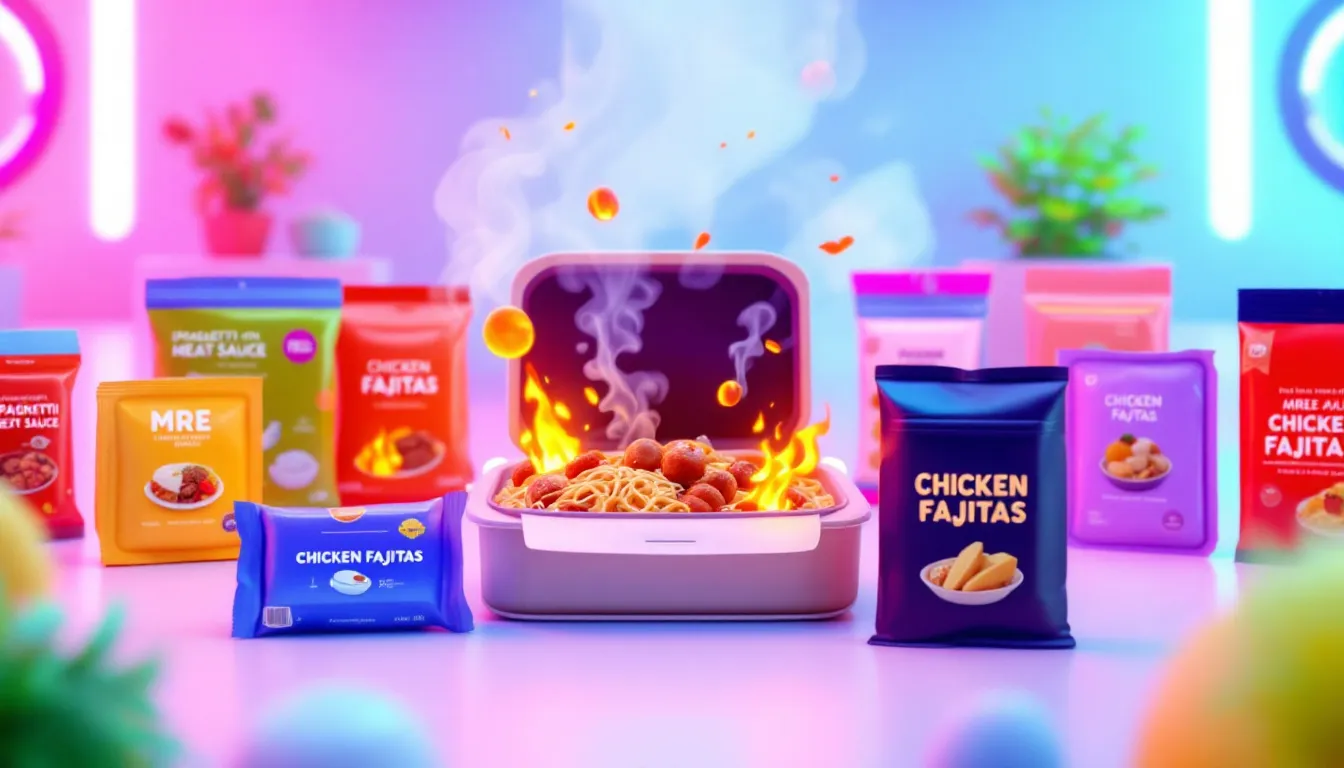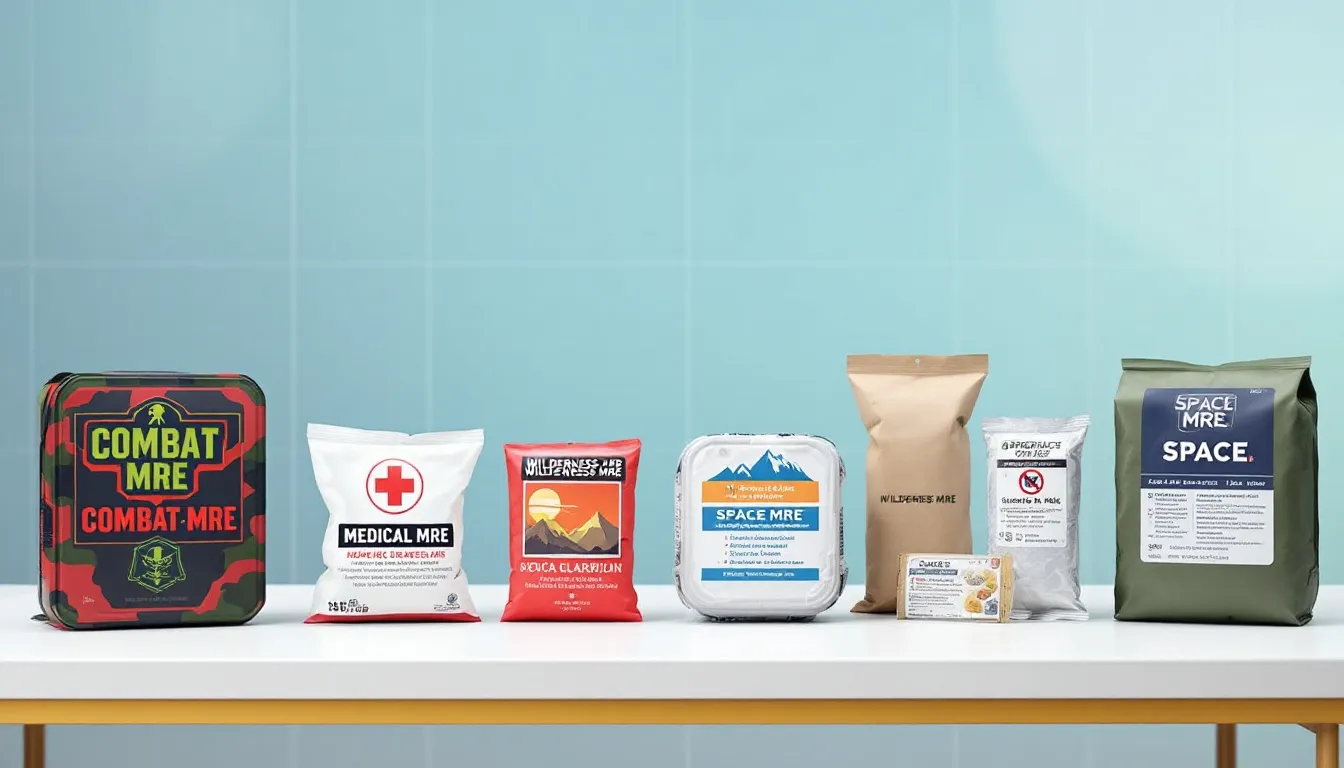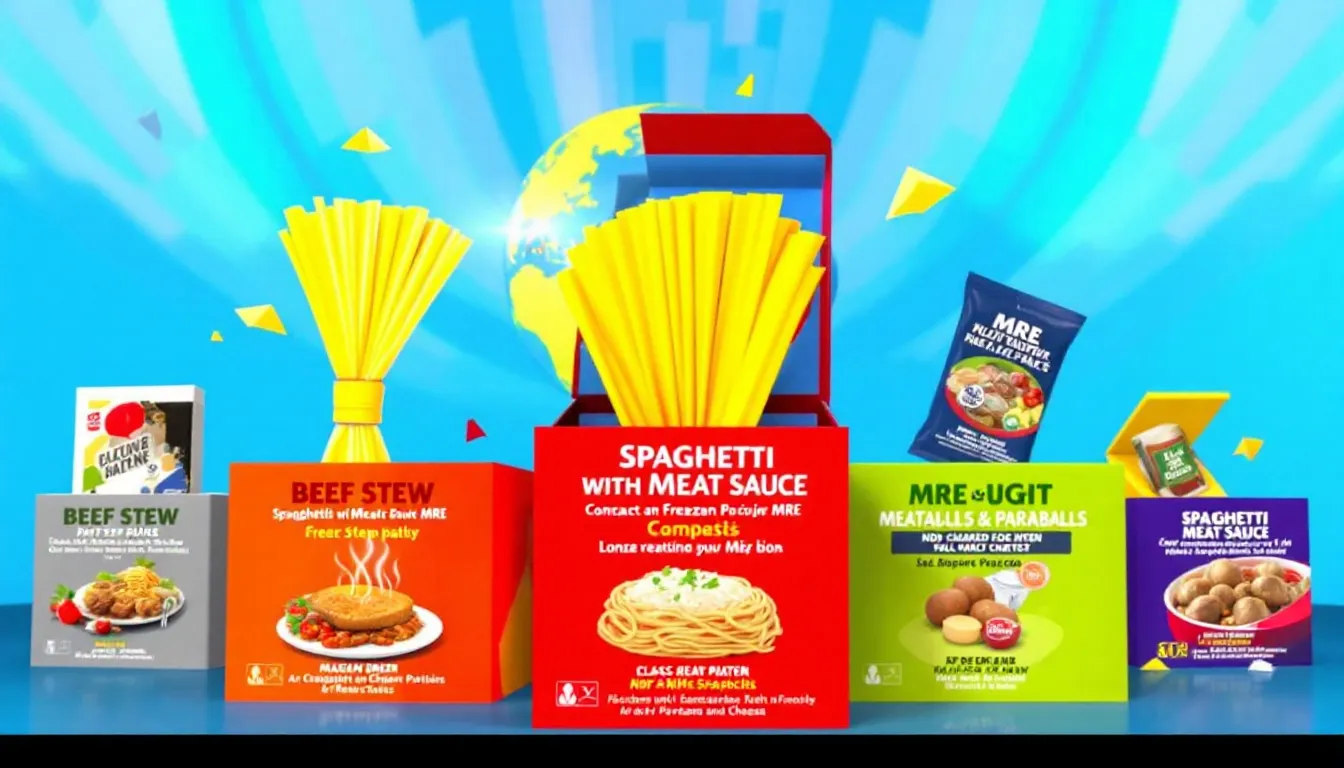What Are Meals Ready to Eat? An In-Depth Guide to MREs
Meals Ready to Eat (MREs) are pre-packaged, ready-to-eat meals originally created for military personnel. They are convenient, nutritious, and perfect for situations where traditional cooking isn’t possible. In this article, we’ll explore what is Meals Ready to Eat, what’s inside an MRE, how to use them, and their benefits.
Key Takeaways
- MREs are self-contained meals designed for convenience, offering balanced portions of entrées, sides, desserts, and a drink mix, ideal for activities requiring high energy.
- They come equipped with a flameless ration heater for easy meal preparation in the field, and can last up to three years at 80°F, extending to over seven years under optimal conditions.
- Specialized MRE variants cater to specific dietary needs, including vegetarian and religious options, ensuring that everyone has access to nutritious meals in various scenarios.
Understanding MRE Components

At the heart of every MRE is a carefully balanced meal designed to provide sustenance and energy. Each ready-to-eat MRE is a self-contained package that includes:
- an entrée
- side dishes
- dessert
- crackers
- a drink mix
- utensils
This thoughtful assembly ensures that every part of the entire meal is meals ready to eat and satisfying.
The average MRE meal packs a punch with approximately 1250 kilocalories, making it suitable for active individuals who need substantial energy. This high-calorie content ensures that you get the necessary nutrition to keep you going, whether you’re in a combat zone or on an adventurous hike.
Desserts like cookies or pound cake add a touch of sweetness to many MREs, making the meal feel more complete and enjoyable. With around 24 different meal options currently available, there’s a variety of flavors and combinations to keep things interesting. From savory entrées to delightful desserts, MRE menus cater to diverse tastes and preferences.
The beauty of MREs lies in their convenience and comprehensiveness. Everything you need for a meal is included, eliminating the need for additional food items or utensils. This makes MREs a perfect choice for situations where traditional dining setups are impractical or impossible.
How to Consume an MRE

Consuming an MRE is an experience in itself, thanks to the innovative flameless ration heater (FRH) included in each pack. This heater allows you to warm your meal without the need for a fire or stove, making it incredibly convenient in the field.
Activating the FRH is simple: just add about 30 milliliters of water to the heater, place your entrée inside, and wait a few minutes. The chemical reaction raises the meal’s temperature to around 160°F (71°C), ensuring your food is hot and more flavorful. This method enhances the overall eating experience, allowing you to enjoy a warm meal even in the most challenging conditions.
Alternative heating methods, such as using hot rocks or boiling water, are available for those who enjoy DIY solutions. You can use hot rocks or place the MRE in boiling water to achieve a similar effect. These alternatives are useful if you don’t have access to the standard FRH or if you want to experiment with different heating techniques.
Consuming an MRE means unpacking and assembling its various components. Start with the entrée, add the sides, and don’t forget the drink mix to wash it all down. An MRE’s self-contained nature provides everything needed in one package, making it practical and efficient for any situation.
Shelf Life and Storage Conditions
One of the standout features of MREs is their impressive shelf life. On average, an MRE can last about three years when stored at 80°F. This longevity makes them ideal for emergency preparedness, long-term storage, and extended missions where resupply may not be possible.
Under optimal storage conditions, such as keeping the MREs at cooler temperatures, their shelf life can extend even further. Storing MREs at 60°F can push their usability to over seven years. This extended shelf life ensures that you have access to reliable food supplies for an extended period, which is crucial in uncertain situations.
High temperatures can significantly reduce the shelf life of MREs, especially if stored over 100°F, leading to a considerable decrease in longevity. Storing MREs in a cool, dry place is crucial for maintaining their quality and edibility.
Proper storage conditions, such as avoiding extreme heat or moisture and ensuring secure packing, preserve the nutritional value and taste of MREs. Following these guidelines ensures your MREs remain a reliable food source whenever needed.
Where to Purchase MREs

Finding the right place to purchase MREs can be a bit tricky, especially since military MREs are not sold to the public. However, civilian versions of these meals are widely available and can be purchased both online and in physical stores.
Online marketplaces like eBay offer both civilian and military MREs, but it’s important to exercise caution. Counterfeit products can be a concern, so it’s crucial to buy from reputable sellers and verify the authenticity of the MREs. This ensures that you receive high-quality, safe-to-consume meals.
For those who prefer to see the product before buying, many Army/Navy surplus stores stock civilian MREs. These stores often provide a reliable source for purchasing MREs, with prices typically around $100 per case. Additionally, online retailers such as MREMarketplace.com and TheReadyStore.com offer a range of civilian MREs from trusted brands like Ameriqual, Meal Kit Supply, and Sopakco.
Specialized MRE Variants

MREs are not one-size-fits-all; they are tailored to meet specific dietary needs and operational requirements. For instance, there are vegetarian MRE options that include dishes like creamy spinach fettuccine and vegetable crumbles. These variants ensure that those with dietary restrictions can still enjoy nutritious and delicious meals.
Religious dietary needs are also catered to with specialized MREs such as Meal, Religious, Kosher/Halal. These meals comply with dietary laws, making them suitable for individuals who observe religious dietary practices.
In extreme conditions, high-calorie MRE variants like the Meal, Cold Weather (MCW) are available. These meals are designed for cold environments and contain increased caloric and fat content to provide the necessary energy and warmth. This makes them ideal for missions in harsh, cold climates where additional nutrition is crucial.
These specialized variants ensure that all dietary needs are met, leaving no one without a suitable meal option. This inclusivity highlights the versatility and adaptability of MREs in various scenarios.
Historical Development of MREs
MREs began their journey during World War II with the K-Ration, designed for paratroopers needing lightweight and portable meals. These early rations provided three meals, each with a variety of food items to sustain soldiers during their missions.
The C-Ration, introduced in World War II, aimed to support longer missions. It included a variety of canned meals, although soldiers often found them repetitive and uninspiring. Despite their flaws, these rations laid the foundation for future developments.
The Vietnam War saw the introduction of the Meal, Combat, Individual (MCI), which offered a more varied menu. However, the MCI still faced complaints about monotony, leading to further innovations. The Long Range Patrol (LRP) ration was also developed during this period, providing lightweight dehydrated meals for specific operations.
Developed in the 1980s, the modern MRE marked a significant leap forward. These self-contained meals include a balanced entrée, sides, snacks, a beverage, and a flameless heater for warming. The introduction of MREs addressed many of the issues with previous rations, offering improved taste, variety, and convenience.
This historical evolution showcases the continuous efforts to improve operational rations, ensuring that military personnel have access to nutritious and enjoyable meals during actual military operations, regardless of their location or mission.
Nutritional Content and Daily Allowance
MREs are meticulously designed to provide the necessary nutrition for individuals engaged in heavy activity. Each MRE contains an average of 1250 kilocalories, ensuring that it meets the high energy demands of military personnel and adventurers.
These meals deliver one-third of the Military Recommended Daily Allowance for essential vitamins and minerals, ensuring that service members receive balanced nutrition. This includes a healthy mix of proteins, fats, and carbohydrates to sustain energy levels and support overall health.
The specific nutritional content of MREs includes 13% protein, 36% fat, and 51% carbohydrates, making them well-rounded meals. This balance helps to maintain stamina and endurance during prolonged periods of physical exertion.
Providing essential vitamins, minerals, and substantial caloric intake, MREs ensure individuals have the necessary nutrition to perform at their best in demanding conditions.
Common MRE Menus

MRE menus offer a wide variety of meal options, catering to different tastes and preferences. Popular dishes like shredded beef in barbecue sauce, chicken with egg noodles and vegetables, and beef stew provide comfort and satisfaction in challenging environments.
Vegetarian options like cheese tortellini and chili with macaroni are also available, ensuring that there is something for everyone. These meals are designed to be both nutritious and enjoyable, making them a staple for those with dietary restrictions.
Complementary items like various rice options and beverages such as coffee and juice enhance the overall meal experience, providing a sense of normalcy and comfort.
Civilian versions of MREs can be purchased from online retailers like MREMarketplace.com and TheReadyStore.com, as well as Army/Navy surplus stores. These outlets offer a range of options from trusted brands, ensuring that you receive high-quality meals.
Operational Use and Practicality
Designed for intensive activities like military training or combat, MREs support individuals when regular food services are unavailable. Their self-contained nature makes them incredibly practical, as each meal is packaged in a lightweight bag that is easy to carry.
The Meal, Long Range Patrol (LRP) is specifically designed for limited supply situations, emphasizing lightweight packaging. This makes it ideal for missions where carrying heavy supplies is impractical.
Additionally, the Modular Operational Rations Enhancement (MORE) provides an extra boost for troops in harsh operational environments. This ration is designed to supplement regular MREs, offering additional nutrition and energy when needed.
In real-world military operations, MREs sustain individuals during heavy activity and combat situations, proving their worth. Their practicality and reliability make them an essential part of military logistics and planning.
Summary
In conclusion, MREs are a testament to ingenuity and practicality, offering a reliable source of nutrition in various challenging scenarios. From their comprehensive components and ease of consumption to their impressive shelf life and specialized variants, MREs are designed to meet the needs of military personnel and adventurers alike.
The historical development of MREs highlights continuous improvements, ensuring that these meals provide essential nutrition and variety. Whether you’re preparing for an emergency or embarking on an outdoor adventure, MREs offer a convenient and effective solution.
Understanding the ins and outs of MREs empowers you to make informed decisions about your food supplies, ensuring that you are always prepared for whatever comes your way.
Frequently Asked Questions
What is an MRE?
An MRE, or Meal Ready to Eat, is a convenient, all-in-one meal pack designed for military use, featuring an entrée, sides, dessert, drink mix, and utensils, perfect for those on the go. It’s like having a complete meal ready whenever you need it!
How long do MREs last?
MREs can typically last about three years at 80°F, but if you keep them at 60°F, they might last over seven years. So, if you want them to stay fresh for longer, store them cool!
Can civilians buy military MREs?
Civilians can't buy military MREs, but you can find civilian versions online or in stores. Just make sure to purchase from trustworthy sources to avoid counterfeits!
Are there vegetarian or specialty MRE options?
Absolutely, there are vegetarian and specialty MRE options available, including kosher and halal variants, so everyone can find a meal that fits their dietary needs. It's great to know that there are choices for everyone!
How do you heat an MRE?
You can easily heat an MRE using the flameless ration heater (FRH) that comes with it—just add water to activate it. If you don't have that, you can also warm it up with hot rocks or boiling water.
